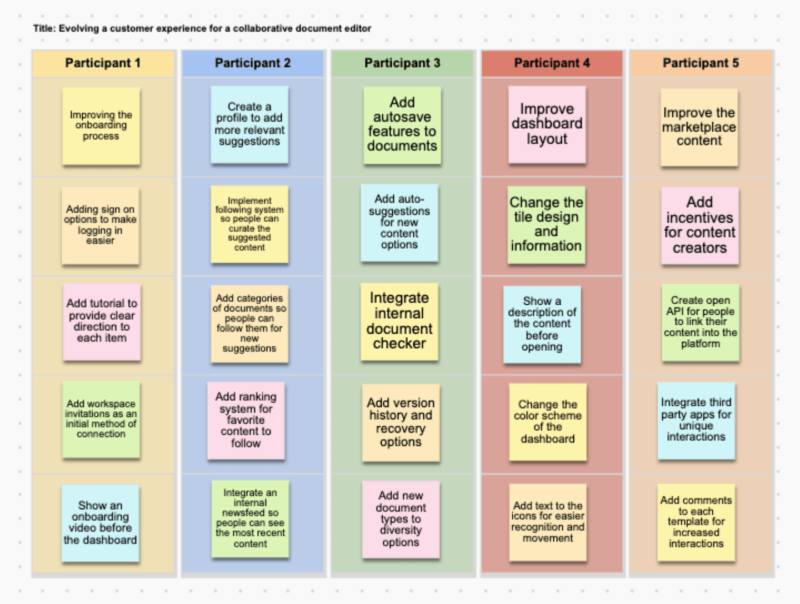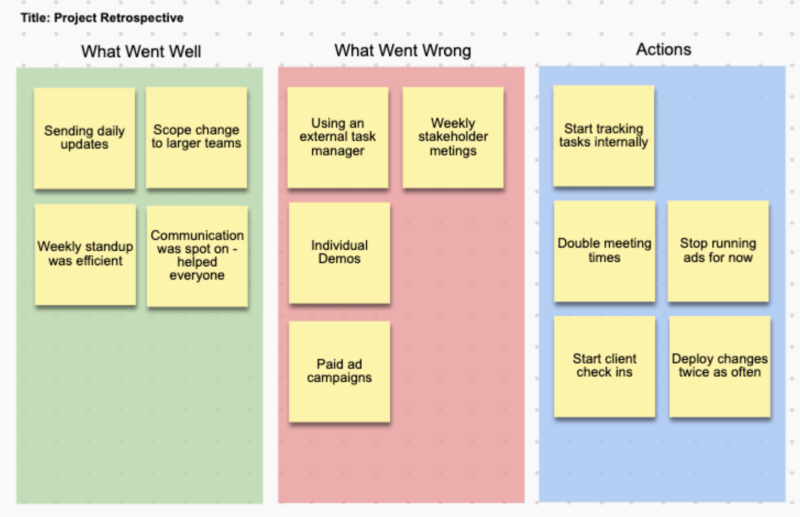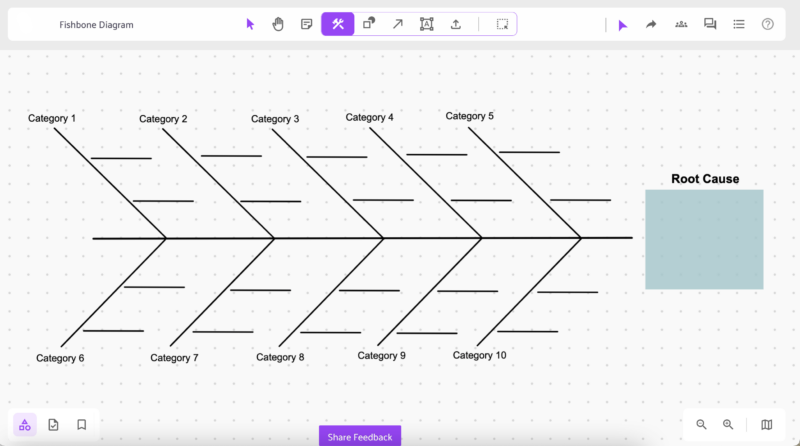Brainstorming with your team can be difficult online, but it doesn’t have to be. Utilizing a structured brainstorming approach allows you to create organized and efficient brainstorming sessions that your team can rely on in a pinch. Below we’ve outlined 20 unique brainstorming templates your team can utilize in a variety of different situations.
Why is Structured Brainstorming Important?
Structured brainstorming applies an organizational framework to your ideation process. Using shared structures means your team doesn’t need to imagine new ideas without any inspiration. In these templates, there will always be patterns of thought or organizational goals guiding them toward a sustainable solution. Additionally, using brainstorming templates can help build problem-solving skills, encourage creative thinking, and formalize collaborative best practices.
Brainstorming Templates To Help Stimulate Your Team
1. Brainwriting
Brainwriting is an exercise that integrates order and efficiency into the brainstorming process. It is detailed in our template guide “The most typical brainwriting format is the 6-3-5 method, where 6 people create 3 ideas in 5 minutes. This process repeats as they find creative ways to build on other people’s ideas before returning to their initial column. Each person will move diagonally to the bottom right after creating their initial idea, expanding on someone else’s idea each step of the way. By doing this, Brainwriting forces teams to find creative solutions while brainstorming within the context of the group.”
Brainwriting is not a typical brainstorming session because it relies on a rigid structure to organize and facilitate collaboration. Still, this adds unique value that can’t be found in a free-form brainstorming session.

2. MoSCoW Analysis
When prioritizing a project, integrating structured collaboration into the process helps stimulate problem-solving and vital conversations. This is exactly what the MoSCoW analysis does.
We define this template as “The MoSCoW analysis enables you to track priorities throughout a project and create a collaborative strategy to align your team. There are four priority categories within the MoSCoW analysis, and they each relate to a different level of importance. The name MoSCoW is an acronym for the categories Must Have, Should Have, Could Have, and Won’t Have.”
The MoSCoW analysis enables teams to efficiently brainstorm priorities for a project while efficiently documenting the entire process. While extremely helpful for prioritization, this template can also be used for more simple brainstorming, considering which ideas have the most traction and should be used in future brainstorming sessions. Whether problem-solving or eliminating solutions, this template is hugely effective at organizing a brainstorming session.
3. SWOT Analysis
The SWOT analysis is one of the most popular brainstorming templates, and for good reason. It is a simple structure that allows teams to quickly brainstorm the advantages and disadvantages of a solution while also looking forward to see how it could open up new opportunities or threats.
This template’s value is focused on analytical brainstorming rather than ideation. When analyzing a solution, business model, or new feature set, a SWOT analysis is extremely helpful in weighing internal and external factors to determine the likelihood of success. While this means it’s not focused strictly on brainstorming to create new ideas, it still can be imperative to stimulate analysis within a team, which is another kind of brainstorming that can be very valuable.
4. Mind Mapping
Mind mapping is the process of drawing connections outward from central ideas to form new relationships and flows of information. This structure can be used in brainstorming to find clarity within a set of information and can be a valuable collaborative tool to express ideas to a team of people. The value of a mind map is evident in our general guide, stating: “It can be used to capture different ideas and display their relationship while organizing them in a way that doesn’t clutter and disorient the brain.”
The emphasis on decluttering the brain is important because many brainstorming sessions, especially through online whiteboards, can become extremely cluttered and confusing. A mind map is an easy way to document ideas without confusing your team.
5. Design Thinking Exercises
Design thinking is a set of principles emphasizing visualization’s importance in the brainstorming process. There are many design thinking exercises that you could integrate with an online whiteboard, and they can be an important change for a team that doesn’t traditionally work with visual elements.
Implementing design thinking in a brainstorming session allows teams to change how they think and communicate through a new medium. Communicating from a different perspective will enable people to open their minds to new ideas and interpret certain solutions differently. In a brainstorming context, breaking the look can be incredibly important, and design thinking is a great way to try something new.
6. Simple T Chart
A T-Chart is one of the most straightforward tools you could use; for that reason, it’s still used in almost every classroom. T charts are a no-nonsense way of communicating and visualizing advantages and disadvantages. In order to be successful, brainstorming requires a strong sense of communication, and T charts make communicating information extremely easy.
If you’ve never used one before, a T chart is essentially a two-column template that organizes advantages and disadvantages into each column, visualizing each of them in its own space. These variables can be replaced with something else if needed.
Using a T chart is helpful because it’s an incredibly simple brainstorming exercise that can be easily manipulated to fit any unique goals. This might be your best bet if you’re looking for a simple brainstorming structure.
7. Venn Diagram
A Venn Diagram is another straightforward structure where you can facilitate brainstorming. This brainstorming template combines multiple variables to create overlapping circles where you can organize different ideas, features, or comments based on which section they fall under. Similar to a T chart, a Venn diagram is incredibly useful when managing a brainstorming session because it allows people to easily communicate information, meaning they can speed up the comprehension process.
Additionally, Venn Diagrams can be edited and combined to form more in-depth, integrated structures. These complex templates can be used to prioritize and organize more complicated sets of information, which could be important for some brainstorming teams. Regardless of the scale at which you implement them, Venn diagrams are helpful brainstorming templates that help your team organize and comprehend information.

8. Incognito Brainstorming
One of the biggest issues with brainstorming is interference with other members. Collaboration can be difficult when one person overshadows the rest of the group, so it’s vital that everyone is able to brainstorm without fear of judgment or influence from other participants.
Online whiteboards easily combat this problem by introducing incognito collaboration. Incognito collaboration allows you to turn off everyone else’s notes on the board, so each person can only see their contributions. After a short period of time, this mode can be turned off to open up the brainstorming session for everyone to see. Once everyone is collaborating together, you can see all of the unique participation people provide when they aren’t influenced by the rest of the group. Especially for integrating the participation of members who might be more introverted, incognito collaboration is a crucial brainstorming template to utilize.
9. Retrospective Analysis
The retrospective analysis is a brainstorming template that helps communicate future needs based on previous projects. This template lets people analyze their last project and determine what they liked, didn’t like, and the actions they can take moving forward.
Brainstorming doesn’t always have to be a linear process, and sometimes looking back at previous work is the best way to brainstorm new solutions for the future. This template makes analyzing old projects easy and gives everyone a direct line of communication to brainstorm how they can make the team’s workflow better in the future.

10. Affinity Diagrams
Affinity diagrams are used to organize thoughts and overcome workplace challenges through brainstorming and creative problem-solving. These brainstorming templates organize information into related groups, which can be extremely helpful when managing the outcomes of a lengthy brainstorming session.
Affinity diagrams are achieved by having all the participants move the notes into similar groups as they accomplish the given thought exercise. By doing so, you can gain a simple idea of what’s relevant, what needs more attention, and what the most controversial ideas are.
Affinity mapping is a great way to provide structure to a brainstorming system that might not inherently be as organized as it should be. If your team is working remotely and struggling to find structure in brainstorming sessions, this is a great place to start.
11. Lotus Diagram
The lotus diagram is a thought exercise that helps teams build solutions from a single problem statement. This template is a brainstorming and organizational tool that helps teams create thoughtful solutions rather than spill any thoughts they might have.
You can create a lotus diagram on IdeaScale Whiteboard by placing a sticky note that represents the main idea you’re focusing on. On every side (and corner) of this initial sticky note, place eight total notes representing a theme or concept related to the main idea. Expanding your ideas to parallel themes and concepts allows you to brainstorm a broader range of topics than an unstructured approach.
12. Six Thinking Hats
The six thinking hats exercise is a good test in teamwork and requires six different people (or groups) to isolate their thoughts to a specific emotion. The categories follow as such:
- Red Hat: Emotions, Feelings
- Yellow Hat: Positivity, Benefits
- Green Hat: Creativity
- Blue Hat: Process
- Black Hat: Risks, Caution
- White Hat: Facts
These six hats represent different angles that your team might approach a problem. When each perspective is focused on and accounted for, your brainstorming session is guaranteed to be more holistic and accountable.
This brainstorming template might not be applicable in every scenario, but when used, it can have a big impact on your team’s ability to brainstorm and find complete solutions.
13. 4 Actions Framework
The four actions framework is a template that helps teams think about the value of their ideas and how to maximize user satisfaction. This framework has four columns: Eliminate, Reduce, Raise, and Create. This template focuses on differentiation from a competitive ecosystem, so it’s important to position your contributions in each column around the industry standard and how you can create something truly unique.
This template is unique compared to the others and is helpful for brainstorming unique differentiations compared to market leaders. When comparing your business to the rest of the industry, it can be challenging to find differentiating features, but this template helps find new gaps in the market where your team can differentiate and create unique value. If you want to look at establishing values internally, try out our values retrospective template.
14. Fishbone Diagram
One of the most important reasons to brainstorm is to understand the root cause of an issue. Using a fishbone diagram is one of the best brainstorming templates to uncover these problems and is an efficient way to problem-solve as a team.
We define the fishbone diagram in our comprehensive guide as follows: “The name “Fishbone Diagram” originates from the skeleton of a fish, which is constructed around a spine with several ribs jutting out diagonally. As you complete the diagram, you will move from left to right, with the smaller lines representing different symptoms and categories of the larger problem. The fishbone diagram culminates at the right side with the head of the fish: the root issue.”
When using a fishbone diagram, your team can easily analyze a complex issue and brainstorm solutions that affect the core issue rather than the common symptoms. This board is one of the most comprehensive brainstorming templates that focuses on problem-solving rather than ideation.

15. Root Cause Analysis
Another valuable template that focuses on problem-solving is the root cause analysis template. This board asks simple why and how questions to discover the symptoms creating issues and, more importantly, the root cause of the problems.
Brainstorming doesn’t always have to be a complicated dance of ideas; sometimes, the best brainstorming templates are the simplest. This template is a straightforward way to address the various problems your organization might experience. It allows participants to focus their efforts on simple issues and ask linear questions until they find the valuable root cause.
16. Ideation Sprints
Ideation sprints are similar to affinity maps in that they take a traditional brainstorming session and change a single element to give it direction. Ideation sprints are essentially traditional brainstorming sessions with an added rush. In this exercise, teams will conduct a brainstorming session while a timer runs, and when it runs out, all the ideas will be collected and analyzed.
The key purpose that the timer serves is an added sense of urgency to the session, where people feel compelled to dash down ideas as fast as possible in order to get as many on the board as they can. Additionally, it’s important to emphasize that no ideas will be discussed or analyzed during the ideation period, as this is strictly handled in the aftermath.
One benefit of this brainstorming template is that it ensures every idea makes its way onto the board. Because there is a time crunch and people aren’t discussing every idea being brought up, there will never be a case where an idea is shot down before it makes it onto the template. This means that more ideas will be discussed and fleshed out than before because there are simply more options available.
Where traditional brainstorming methods might restrict ideas that are premature or not proposed with confidence, ideation sprints are a great way to ensure everyone’s ideas are heard by the team.
17. Single File Brainstorming
Single file brainstorming is a type of ideation that is probably very familiar to people as it’s reasonably straightforward compared to the other brainstorming templates. In this exercise, each member contributes one idea to the group, and everyone else has a chance to speak before anyone gets a second chance. Another important rule is that people must contribute a unique idea, regardless of if their first choice was already taken. In this way, it’s the opposite of an ideation rush because every idea is carefully considered and touched on by every participant.
The advantages of conducting single file brainstorming are that everyone is ensured their opinion will be heard, regardless of their position or thoughts. This inclusionary mindset helps people overcome some of the possible difficulties with collaboration and guarantees they have a slot reserved just for them.
18. XY Matrix
Using an XY matrix is an incredibly simple way to organize elements on a scale, and when brainstorming solutions, this organization can be beneficial. The XY matrix is a simple two-axis graph that measures elements based on their placement on each scale. When evaluating solutions, analyzing priorities, or brainstorming ways to target certain customers, using this matrix can help clarify what’s most important and kick off a successful brainstorming session.
19. Reverse Brainstorming
Reverse brainstorming is a template that aptly reverses the brainstorming process and requires teams to think of various problems instead of solutions. This template focuses on team anticipation and allows you to spot issues before your future project.
The template starts by clarifying a central problem and brainstorming different problems that would worsen the situation or harm the team’s ability to handle the problem. After ideating multiple problems, you reverse the process again to find solutions to the previously raised issues.
This template provides an angle to brainstorming that most teams won’t have covered before and can help to push people’s creative boundaries.
20. KWL Chart
The KWL chart is similar to a retrospective, focusing on your team’s takeaways from a certain activity or project. This template has three columns: what I know, what I wonder, and what I learned. These columns allow you to brainstorm ideas about what can be improved or convey a concept to a group. This template helps facilitate brainstorming and integrates new learning for people.
When using a simple structure to facilitate brainstorming, it’s crucial to ensure everyone can participate. By phrasing the columns as “I” statements, it encourages different parties to share their thoughts and brainstorm collaboratively.
Learn more: 7 Brainstorming Examples for Online Whiteboards
Conclusion
Whether you’re problem-solving for the future or adding structure to an existing brainstorming framework, these 20 brainstorming templates are some of the best ways to integrate visual collaboration into your workflow and increase the creative capital of your team.
Most Recent Posts
Explore the latest innovation insights and trends with our recent blog posts.













